Motorola Moto E (2nd Gen) Review: A Great Budget Smartphone
The new Motorola Moto E offers Android Lollipop, LTE speeds and a customizable design for just $150.
Why you can trust Tom's Guide
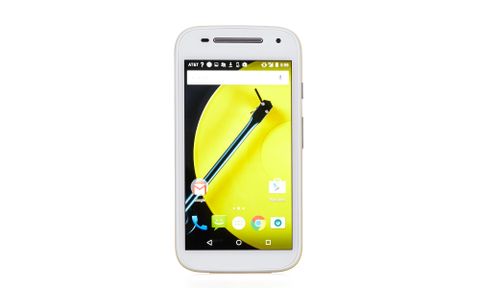
Whether you're buying your first smartphone or you just want a capable handset on the cheap, Motorola's new Moto E ($150) should be on your short list. This follow-up to the original Moto E now supports 4G LTE, sports a front-facing camera for selfies and features a larger display. As with the original, you also get interchangeable shells to help you stand out. Despite some minor drawbacks, this is a great choice for the budget-conscious shopper.
Design
The Moto E has a solid, plastic body available in matte white or black, is slightly curved on all edges, and features a small, dime-size indentation under the camera. I liked this groove, as it offered a comfortable grip.
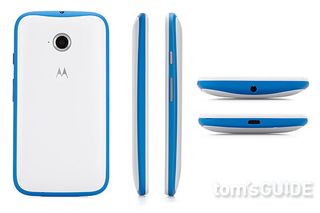
The Moto E's 4.5-inch Gorilla Glass display (up from 4.3 inches on its predecessor) is framed by a thin white bezel, and a speaker and VGA front camera sit atop the screen. On the top edge is a 3.5mm headphone jack, while the bottom houses a microUSB port. A volume rocker and power button line the right side.
At 5.11 x 2.62 x 0.48 inches and 5.11 ounces, the Moto E was a dainty addition to my purse. Although a little heavy for its display size, it's smaller and lighter than the 2014 Moto G (5.57 x 2.78 x 0.24-0.43 inches, 5.25 ounces), which has a 5-inch display. I also like that the Moto E has a water-resistant coating, the same as its predecessor.
MORE: Best Smartphones
My Moto E came with a white band lining its edges, and two swappable bands in blue and yellow. You can also pop out the back cover and replace it with a Grip Shell (available in five colors for $20 each). Additional bands cost $20 for a set of three colors or $15 for a pair in white and black. The band is easy to replace, thanks to a groove on the phone's bottom left corner.
Display
The new Moto E's 4.5-inch, 960 x 540 IPS touch display is small and low-res by today's standards, but it's bright and colorful. Scarlett Johansson's flaming red hair looked vibrant in a trailer for Avengers: Age of Ultron; the rings on Thor's hammer were clear but not tack sharp. Viewing angles were relatively narrow, with images dimming when I tilted the phone beyond 45 degrees away from me.
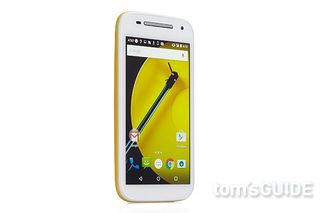
Notching 393 nits on our brightness meter, the Moto E (2nd Gen) is brighter than the average smartphone (371 nits) and the Moto G (303 nits). The new Moto E can also display plenty of colors, delivering 103.2 percent of the sRGB color gamut. While that's less than the average smartphone (115.3 percent), it's more than the Moto G's 94.2 percent.

With a Delta E score of 2.4, the Moto E's display is much more accurate than those of the average smartphone (5.4) and the Moto G (4.5). Numbers closer to 0 are better.
Audio
You'll be able to hear the meows from your favorite cat videos just fine, but don't expect to party with the Moto E's speaker. Taylor Swift's voice clashed against the vocals in "Style," sounding tinny at times. Drums and guitars in "Losing My Religion" by R.E.M. were hollow.
Notching 74 decibels on our audio test (playing a tone and measuring from 13 inches away), the Moto E (2nd Gen) is softer than the average smartphone (80.9 dB) and the 2014 Moto G (84 dB).
Performance
You'll find the Moto E's 1.2-GHz quad-core Snapdragon 410 CPU and 1GB of RAM capable of handling most day-to-day tasks, but anything more taxing could cause lag. I played a round of the first-person shooter N.O.V.A. 3 smoothly with apps such as Chrome, Gallery, Moto, Downloads and Camera open. While launching apps and going back to the home screen was mostly zippy, the Moto E's camera was slow to fire multiple successive shots.
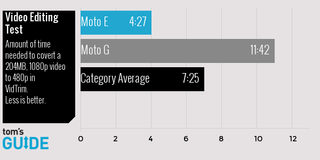
The Moto E did well on our video editing test, taking just 4 minutes and 27 seconds to convert a 204MB, 1080p video to 480p in VidTrim. That's faster than the average smartphone (7:25) and the 2014 Moto G (11:42).

On Geekbench 3, which measures overall performance, the new Moto E's score of 1,282 puts it behind the average smartphone (2,072), but ahead of the 2014 Moto G (1,153).

With a 400-Mhz Adreno 306 graphics card, Moto E fell short in graphics performance. Its 3DMark Ice Storm Unlimited score of 4,492 is a third of the average smartphone's showing (13,366) and lower than the Moto G's score (4,717).
Software and Motorola Apps
The Moto E runs a nearly stock version of Android 5.0 Lollipop, and just as on the Moto X and the Moto G, comes with plenty of personalized software to make life a little easier.
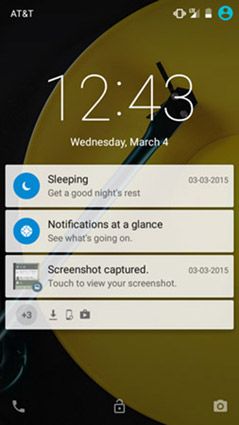
With the Moto app, you can set your phone to keep the screen off at specified times (such as at night when you're sleeping). Android's Downtime Settings silences your notifications and only alerts you when someone on your Favorites list calls or sends a message. You can also set an auto-reply to missed calls from your Favorites when you're in a meeting.

Motorola packed nifty gestures into the Moto E as well. You can launch the camera app by flicking or twisting your wrist quickly twice, and repeat the action to turn the selfie cam on. While I appreciated this convenient feature, it's a rather odd gesture — my roommate was worried I was trying to throw away the phone instead of launch the app.

Lazy users like myself will appreciate being able to say "OK, Google" when the Home screen is open to activate voice control. The Moto E recognized my commands well, opening Chrome and showing me the weather forecast, despite a noisy episode of Spartacus: Vengeance playing in the background. Unlike on the Moto X, though, you'll only be able to use the "OK, Google" command to activate Google Now on the home screen.

Just as on the Moto G (2014), Motorola has bundled the Alert app to send your location to emergency contacts. You'll also get Migrate for porting your contacts, photos and accounts to or from a different phone, whether it's a Moto, iPhone or other device.
Motorola also tosses in an FM Radio app so you can tune in to your favorite channel by plugging in a set of headphones.
Camera
Considering its price, the new Moto E is a capable shooter. The 5-megapixel rear camera took accurately colored pictures, with green road signs and yellow cabs looking true in my shots of Manhattan streets. Words on the street signs were clear, but some details, such as yellow traffic lights, looked splotchy.

With HDR activated, the Moto E delivered an impressively sharp picture of the Flatiron building, although colors were somewhat inaccurate; yellow stoplights looked orange.
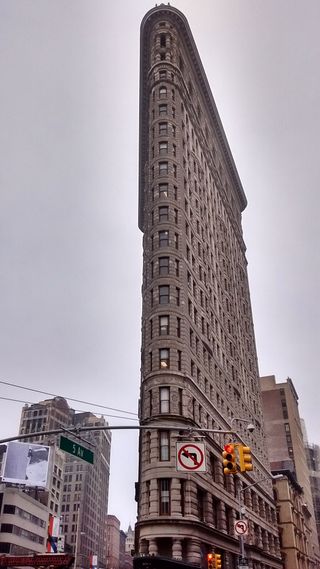
In low light, pictures came out bright but noisy. I could identify individual buildings in the Manhattan cityscape shot from my balcony at night, but details, such as the Allianz building's name, were blurry. The picture was also filled with noise.

The rear camera lacks a flash, so if you want to light up your low-light shot, you'll have to get creative or find another light source.
MORE: The Best Smartphone Cameras
Video quality was similarly lackluster. In my 720p (highest-resolution) clip of Manhattan street traffic, yellow cabs looked orange, but details, such as names on storefronts, were clear.

Selfie lovers may want to steer clear of the Moto E. While it now has a front-facing camera, something the original Moto E lacked, its VGA resolution results in dull, grainy pictures. My face looked fuzzy and was covered with colored specks, and my bright green headphones looked more like pastels. The shot had a green cast overall.
Battery Life and Configurations
The Moto E's 2,390-mAh battery will last you the whole workday. Lasting 8 hours and 32 minutes on our battery test (continuous Web surfing at 150 nits) on AT&T's LTE network, the Moto E offers slightly more endurance than the average smartphone (8:22) and the Moto G 2014 (6:30).
MORE: Best Smartphones on the Market Now
Those who don't need LTE speeds can consider the 3G version of the Moto E, which starts at just $120. It has a lower-power Qualcomm Snapdragon 200 processor, the same as in the original Moto E.
Moto E vs. Moto G
Which Moto should you get? The Moto G (2014) offers a clean Android experience and a larger and sharper 5-inch 720p screen than the Moto E, all for just $30 more. Smartphone photographers will also appreciate the Moto G's sharper 8-MP rear and 2-MP front cameras.
But with no LTE support, a shorter runtime (6:30) and poorer performance than the Moto E, the Moto G falls short of its smaller sibling. Plus, it ships with Android KitKat, while the Moto E comes with the newer Lollipop.
Bottom Line
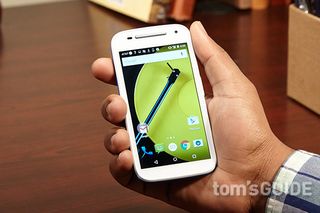
The second generation Moto E is one of the best unlocked-smartphone values yet. You get the latest Android OS (sans bloatware), 4G LTE, and a bright and colorful display in a solid, comfortable and customizable body. Plus, the Moto E offers long battery life. However, while the Moto E takes fairly clear pictures outdoors, the front camera is so-so. Overall, the Moto E is a great choice for a starter phone.
Sign up to get the BEST of Tom's Guide direct to your inbox.
Get instant access to breaking news, the hottest reviews, great deals and helpful tips.
Cherlynn is Deputy Editor, Reviews at Engadget and also leads the site's Google reporting. She graduated with a Master’s in Journalism from Columbia University before joining Tom's Guide and its sister site LaptopMag as a staff writer, where she covered wearables, cameras, laptops, computers and smartphones, among many other subjects.
